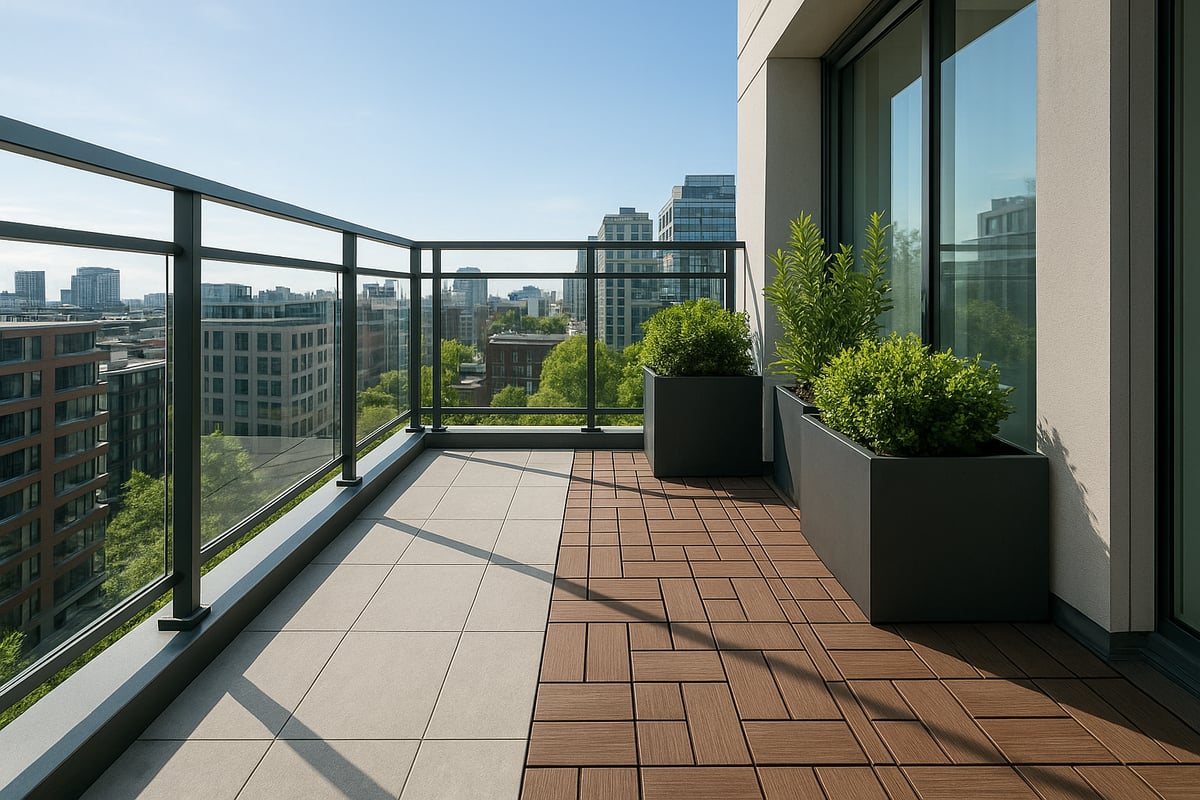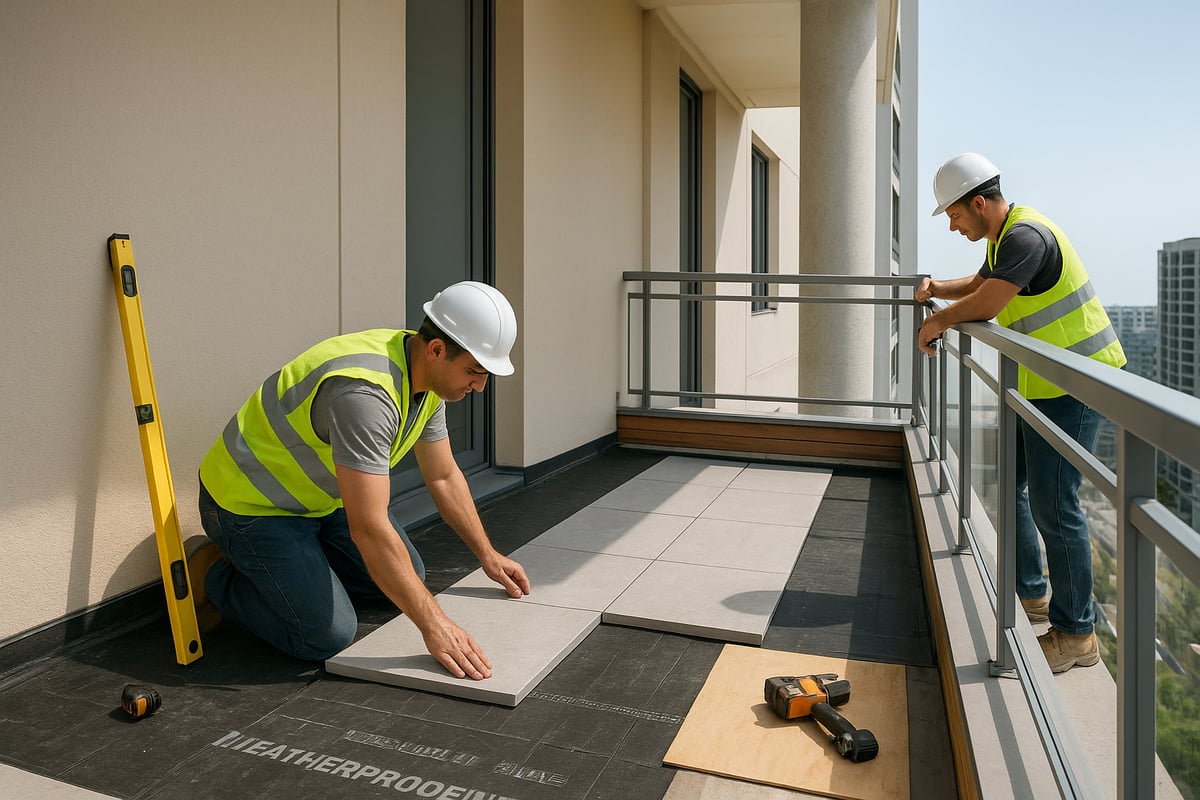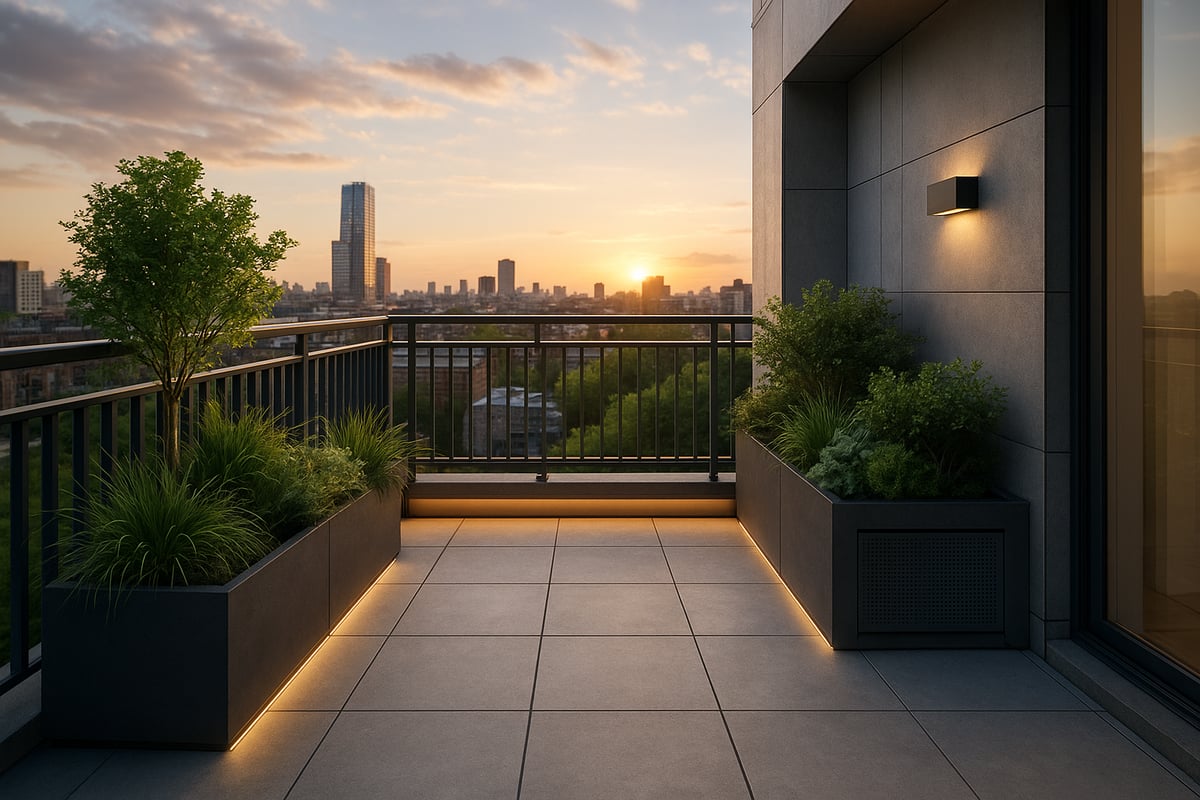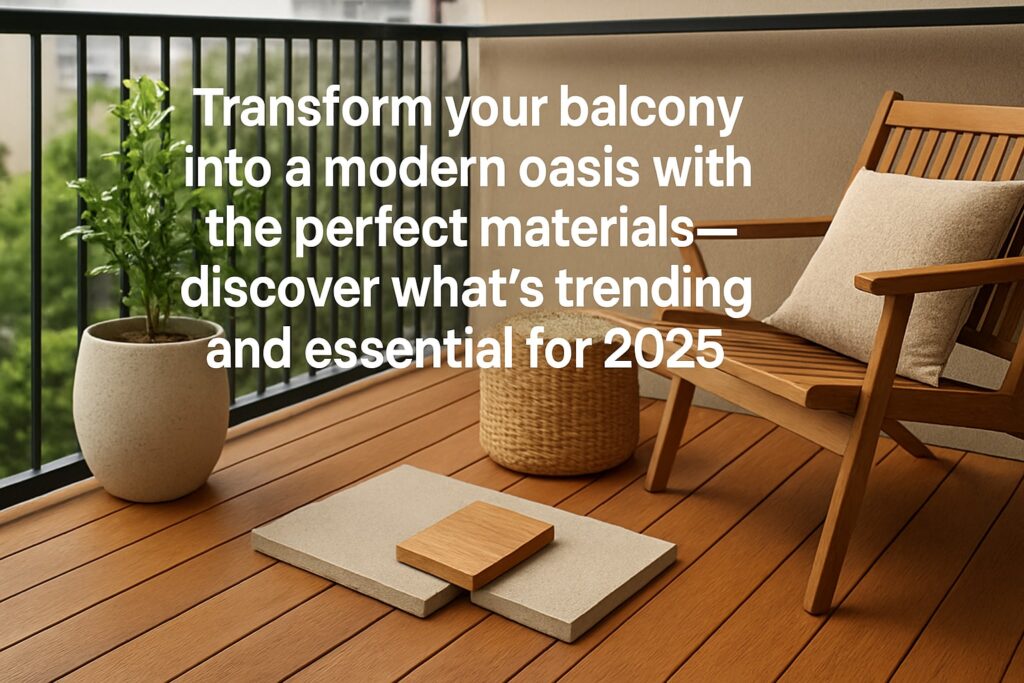Transform your balcony into a modern oasis with the right choices for 2025. The right balcony materials can dramatically increase your property’s value, safety, and enjoyment.
This expert guide will walk you through the latest balcony materials, essential considerations, and expert tips to help you create a stylish, durable, and safe outdoor space.
Stay ahead of trends, understand important new regulations, and learn how to confidently choose the best solutions. Use this guide to ensure your balcony project exceeds expectations.
Key Considerations When Choosing Balcony Materials
Selecting the right balcony materials is a crucial step in any project, influencing safety, style, and long-term value. Thoughtful choices can help you avoid costly mistakes, meet legal requirements, and create a balcony that stands the test of time.

Understanding Building Codes & Regulations
Compliance with building codes is the foundation for any balcony materials decision. Local and national codes dictate load-bearing capacity, drainage, and fire safety, directly impacting what materials you can use.
Recent updates, such as the 2018 UK fire regulation changes and California's SB 721/SB 326, now require non-combustible materials for many multi-family structures. These evolving standards affect both material selection and installation techniques. For instance, soffits exposed to moisture must use corrosion-resistant options to meet warranty and code expectations.
Design life is another key factor. Many warranties demand a 60-year lifespan, so early code review is essential. Reviewing the 2025 California Balcony Code Updates can help you stay ahead of compliance issues and avoid expensive redesigns.
Climate and Environmental Factors
Climate plays a significant role in how balcony materials perform over time. Freeze-thaw cycles, UV exposure, humidity, and rainfall can all affect durability. In cold regions, frost-resistant materials like porcelain are favored, while metals must be protected from corrosion in humid or coastal areas.
Slip resistance is vital, especially in wet or icy environments. Sustainable choices are increasingly important, with many homeowners seeking eco-friendly certifications and recycled content. Aluminum and composite balcony materials are often chosen in Canadian climates for their resilience and reduced environmental impact.
Safety and Structural Integrity
Safety is non-negotiable when selecting balcony materials. Load-bearing requirements differ between residential and commercial settings, and proper calculations are necessary to ensure stability. Fire resistance is critical, with non-combustible ratings (Class A1) required for metals and some tiles.
Slip resistance standards must be met for flooring, reducing accident risks. Professional assessments are vital before material selection, especially for existing balconies. Galvanized steel and aluminum are reliable options, as they consistently meet stringent safety codes for modern balcony materials.
Aesthetic and Design Goals
Achieving the desired look is another important aspect of choosing balcony materials. The material should complement the building’s architecture and reflect user preferences. Popular finishes include wood-look composites, minimalist porcelain, industrial metals, and glass.
Customization is possible through color, texture, and modular layouts. Integrating railings, planters, and lighting creates a cohesive design. For example, modular deck tiles allow creative patterns and make it easy to update your balcony materials as trends evolve.
Maintenance and Longevity
Long-term performance is a key factor in selecting balcony materials. Consider the expected lifespan and available warranties, as well as ongoing care needs such as cleaning, sealing, and repairs. Low-maintenance trends are growing, with composite, porcelain, and powder-coated metals leading the way.
Porcelain pavers, for instance, require little upkeep compared to natural wood, making them a smart choice for busy homeowners.
Comparative Guide to Popular Balcony Materials
Selecting the right balcony materials is essential for achieving long-lasting performance, safety, and style. Each option brings unique benefits and considerations, making it important to compare features side by side. Whether you are upgrading an urban loft or building new, understanding the strengths of each material will help you make an informed decision for your balcony project.

Aluminum
Aluminum is one of the most popular balcony materials for modern projects. It is lightweight, rust-proof, and non-combustible, making it a top choice for frames, railings, and soffits. Aluminum performs exceptionally well in wet environments and meets demanding durability requirements including the 60-year design life standard. It is compatible with stainless steel fixings, but must be isolated from galvanized steel to avoid galvanic corrosion. Aluminum is widely used in both the UK and Canadian balcony construction sectors, where it supports sleek, contemporary designs and strict safety standards.
Galvanized Steel
Galvanized steel stands out among balcony materials for its strength and cost-effectiveness. It is especially suitable for structural elements, such as frames and supports. The hot-dipped galvanizing process protects steel against corrosion, which is crucial for compliance with warranties and extending lifespan. Though heavier than aluminum, galvanized steel can be combined with other metals for hybrid systems. It is non-combustible and meets rigorous fire safety codes, making it a common choice for high-rise balcony frames in urban developments.
Stainless Steel
When it comes to premium durability, stainless steel leads the way among balcony materials. Especially in the 316 marine grade, it offers exceptional resistance to corrosion, even in coastal or high-humidity environments. While stainless steel is more expensive than other options, its longevity and ability to meet strict safety codes justify the investment. Commonly used for fasteners, balustrades, and accent features, stainless steel is a favorite in luxury developments and waterfront properties, where both aesthetics and performance are paramount.
Porcelain Pavers and Tiles
Porcelain pavers have become increasingly popular as balcony materials thanks to their durability, slip resistance, and low maintenance needs. Typically 2CM thick, these tiles are frost-resistant and available in a wide variety of finishes, including stone, wood, and concrete looks. Porcelain pavers are installed on pedestal systems, which aid drainage and waterproofing. As non-combustible materials, they are suitable for rooftops, terraces, and balconies in both residential and commercial projects. Their modern appeal is driving their adoption in urban settings.
Composite Decking and Tiles
Composite decking is among the most versatile balcony materials, made from recycled wood fibers and plastics. These modular systems are easy to install, available in many colors and textures, and resistant to rot, splintering, and fading. Composite tiles are especially popular for condo balconies and patios, but must be verified for code compliance, particularly fire safety. For a deeper dive into options, see the Composite Deck Tiles Guide, which details benefits and installation tips for these eco-friendly systems.
Exotic Hardwood Decking
Exotic hardwoods like IPE are highly prized balcony materials, offering natural beauty and superior durability. They require regular sealing to maintain their appearance and can be installed as removable, floating systems for easier maintenance. While the initial investment is higher, these hardwoods have a long lifespan if properly cared for. Some species meet certain fire codes, though they may not be fully non-combustible. They are especially popular in luxury and high-end residential projects where aesthetics are a priority.
Glass and Other Materials
Glass balustrades are chosen as balcony materials to maximize views and natural light. They require toughened safety glass for compliance and durability. Concrete is another option, valued for its strength and often used in structural slabs. Hybrid systems, which combine glass, aluminum, and other materials, are increasingly popular for achieving a modern, cohesive look. For instance, pairing glass with aluminum creates a sleek, contemporary balcony favored in new urban developments.
Summary Table: Popular Balcony Materials Comparison
| Material | Durability | Maintenance | Fire Safety | Aesthetic Options | Eco-Friendly |
|---|---|---|---|---|---|
| Aluminum | High | Low | Excellent | Modern/Minimalist | Moderate |
| Galvanized Steel | High | Medium | Excellent | Industrial | Moderate |
| Stainless Steel | Very High | Low | Excellent | Luxury/Accent | Moderate |
| Porcelain Tiles | High | Very Low | Excellent | Versatile | High |
| Composite | High | Low | Varies | Wood-look | High |
| Hardwood | High | High | Good | Natural/Luxury | Varies |
| Glass | High | Low | Good | Transparent | Moderate |
No matter which balcony materials you choose, balancing durability, safety, and style is key to a successful project.
Expert Installation Tips for Balcony Materials
A successful balcony project depends not only on choosing the right balcony materials but also on expert installation. Every step, from initial assessment to the final finish, impacts safety, durability, and satisfaction. Below are essential tips to ensure your balcony materials perform at their best.

Assessment and Preparation
Before installation begins, a thorough assessment of the existing structure is crucial. Professionals inspect the substrate for soundness, slope, and any moisture or drainage concerns. This initial step helps identify hidden issues, such as mold or water damage, which could compromise the performance of your balcony materials.
Repairs or remediation should be completed before new materials are installed. For example, if the substrate is uneven or damaged, it may need leveling or replacement. Skipping this step can lead to long-term problems and costly repairs later.
Whether you are working with a new or existing balcony, a careful, professional evaluation sets the foundation for a safe and lasting result.
Waterproofing Essentials
Waterproofing is one of the most important aspects of installing balcony materials. Without proper protection, water can infiltrate and cause structural damage or premature failure. Professionals typically use either liquid-applied or sheet membranes, each offering unique benefits.
Liquid-applied membranes are seamless and adapt well to complex shapes, while sheet membranes offer consistent thickness and easy inspection. The slope of the balcony must be checked to ensure water drains away from the building, as standing water can quickly deteriorate materials.
Specialized waterproofing systems are required for both plywood and concrete substrates. Proper waterproofing ensures your balcony materials resist weather, moisture, and the test of time.
Installation Techniques by Material Type
Each type of balcony materials requires specific installation methods. For metals like aluminum and steel, bolted or welded connections are standard. It is essential to use isolation materials to prevent galvanic corrosion when combining metals.
Porcelain pavers are commonly installed on pedestal systems, which provide level surfaces and effective drainage. For more details on installation options, see Porcelain Decking Solutions. Composite tiles use click-together systems, making them suitable for both DIY and professional installations.
Hardwood decking is often installed as a floating or removable system, allowing easy access for maintenance. Using fast-drying, low-odor adhesives or finishes helps minimize disruption, especially in occupied buildings. Each technique ensures that balcony materials are secure, compliant, and ready to withstand daily use.
Safety and Compliance During Installation
Following safety codes and regulations is essential when installing balcony materials. Installers must adhere to fire, load-bearing, and railing standards set by local and national regulations. Using certified professionals ensures compliance, which is often required for warranties and insurance.
Critical checkpoints during installation include inspecting the substrate, verifying waterproofing, and confirming the final finish meets code. In multi-unit projects, phased or compartmentalized installation is common, allowing for continuous safety inspections.
Ensuring every aspect of the installation meets legal and safety standards protects both the building and its occupants.
Maintenance Planning
A proactive maintenance plan extends the life of your balcony materials and preserves their appearance. Regular inspections help identify wear, water damage, or loose fasteners before they become major issues.
Cleaning routines should be tailored to the specific material. For example, porcelain tiles can be power washed, while hardwoods may require gentle cleaning and periodic sealing. Planning for easy access to waterproofing layers, such as using removable deck tiles, simplifies future repairs and maintenance.
Consistent care ensures your balcony materials retain their safety and beauty year after year.
Cost and Timeline Considerations
Several factors influence the installation cost of balcony materials, including your chosen material, labor rates, and site accessibility. Some materials, like modular tiles or pedestal pavers, can reduce installation time and disruption.
Professional installation may carry a higher upfront cost but often results in lower maintenance and longer-lasting balcony materials. Planning your project timeline with these factors in mind helps avoid surprises and ensures a smooth installation process.
Balcony Material Trends for 2025
Balcony materials are evolving rapidly, and 2025 will see significant shifts in both performance and style. As architects, designers, and homeowners seek smarter, safer, and more sustainable options, understanding these trends is critical. The following sections highlight what to expect in the coming year, helping you make informed decisions for your next balcony project.

Sustainability and Eco-Friendly Options
Sustainability is at the forefront of balcony materials trends for 2025. Demand for products made from recycled content is rising, with composite decking now often containing over 90% reclaimed wood and plastics. Homeowners and developers are also seeking materials certified by organizations like FSC for wood and EPD for composites and tiles.
Modular systems are gaining popularity as they reduce installation waste and make future upgrades simple. Many balcony materials are now designed for full recyclability at end of life, lowering environmental impact. Selecting eco-certified balcony materials not only benefits the planet but can also enhance property value and market appeal.
Fire Safety Innovations
Stringent fire codes are driving major changes in balcony materials selection. In 2025, expect an increased focus on A1 non-combustible products such as aluminum, galvanized steel, and porcelain tiles. These materials meet the strictest fire safety standards, making them ideal for both new builds and retrofits.
Advances in fire-retardant coatings and treatments are expanding the possibilities for safer balcony materials. For example, some composite options are now formulated to achieve higher fire ratings, broadening their application in multi-unit residential projects. Always confirm that chosen balcony materials comply with local fire regulations for peace of mind and legal compliance.
Modular and Removable Systems
The trend toward modular and removable balcony materials is transforming urban living. Floating deck systems, pedestal pavers, and click-together tiles allow for flexible layouts and easy access to underlying waterproofing. This makes maintenance more manageable and enables quick repairs without major disruption.
Modular balcony materials are especially popular in condos and multi-unit buildings, where code compliance and ease of inspection are essential. These systems also offer design versatility, allowing residents to update finishes or patterns as trends change. The adaptability of modular balcony materials supports both short-term needs and long-term value.
Smart Features and Integrated Accessories
Smart technology is making its mark on balcony materials and accessories. Integrated LED lighting, built-in planters, and privacy screens are becoming standard in upscale developments. These features not only enhance the user experience but also boost safety and curb appeal.
Emerging innovations include moisture sensors embedded within balcony materials to detect leaks early and automated cleaning systems for glass or tile surfaces. The move toward smart balcony materials aligns with the broader trend of connected living, offering convenience and peace of mind for residents.
Design and Aesthetic Trends
Aesthetics remain a driving force in the evolution of balcony materials. In 2025, natural wood and stone looks continue to be favorites, while minimalist and industrial styles are on the rise. Custom color and pattern options allow for truly unique balcony spaces, with modular systems enabling personalized layouts.
Blending indoor and outdoor design is also trending, creating seamless transitions between living areas. For inspiration and the latest visual directions, explore Modern Balcony Tiles Design Ideas, which showcases creative uses of balcony materials in contemporary settings. Staying ahead of style trends ensures your balcony remains both functional and visually appealing.
Common Mistakes to Avoid When Selecting Balcony Materials
Selecting the right balcony materials is a significant investment, but even experienced property owners can make costly errors. Avoiding these common mistakes will help ensure your balcony project is safe, attractive, and built to last.
Ignoring Local Codes and Regulations
One of the most frequent mistakes is overlooking building codes and safety regulations when choosing balcony materials. Compliance is vital for both legal and safety reasons. For instance, using non-compliant materials after regulatory changes, such as California's SB 326 and SB 721, can result in costly fines or forced renovations. Staying updated on requirements, like non-combustible standards or load-bearing capacities, is essential. Early review of regulations, including Understanding SB 326 and SB 721, helps avoid expensive redesigns and ensures your balcony materials are approved before installation.
Overlooking Climate and Environmental Impact
Choosing balcony materials without considering the local climate can significantly reduce their lifespan. Materials that perform well in dry environments may fail quickly in coastal or humid regions. For example, untreated steel will rust rapidly when exposed to salty air, compromising both appearance and structure. Always assess how freeze-thaw cycles, UV exposure, and rainfall will affect your chosen materials. Prioritize options that are designed for your specific environment, and look for eco-friendly certifications to support sustainability.
Sacrificing Safety for Style
Aesthetic preferences are important, but never at the expense of safety. Selecting balcony materials that look good but lack slip resistance or fire safety features can create hazards. For instance, installing glossy tiles on an outdoor balcony in a rainy climate increases the risk of slips and falls. Fire safety is another critical factor, especially in multi-unit buildings. Always verify that your materials meet or exceed current safety standards, and remember that a stylish balcony should also be a safe one.
Underestimating Maintenance Needs
Some balcony materials require ongoing maintenance that can be time-consuming and expensive. Exotic hardwoods, for example, need regular sealing to maintain their appearance and durability. Failing to plan for this upkeep can lead to premature deterioration, higher repair costs, or even safety issues. Before making a decision, consider how much time and effort you are willing to invest in cleaning, sealing, or repairs. Opting for low-maintenance options is often the smarter long-term choice.
Skimping on Professional Assessment and Installation
Attempting a DIY installation or skipping a professional assessment can have serious consequences. Improper installation of balcony materials can result in water leaks, structural failures, or voided warranties. Issues like inadequate waterproofing or missed substrate repairs are common when experts are not involved. Investing in professional evaluation and installation not only protects your property but also ensures your balcony meets all safety and code requirements.
Frequently Asked Questions About Balcony Materials
Wondering how to choose the best balcony materials for your project? Below, we answer the most common questions homeowners and developers ask about selecting, installing, and maintaining balcony materials for 2025.
What are the most durable balcony materials for harsh climates?
When selecting balcony materials for challenging climates, focus on options that resist freeze-thaw, UV, and moisture damage. Aluminum, porcelain pavers, and high-quality composite decking excel in these conditions. For example, porcelain pavers offer outstanding frost resistance and are widely used in Canada and the northern US. Aluminum is rust-proof and maintains strength, while composite materials resist rot and fading.
How do I ensure my balcony meets fire safety codes?
To comply with modern fire safety requirements, choose balcony materials with A1 non-combustible ratings, such as aluminum, steel, and porcelain. Many regions, like California, have updated codes for 2025. For details on current standards, review the Deck Building Codes for 2025, which highlights compliant materials and installation practices. Always consult local authorities to confirm requirements.
What are the best low-maintenance options for balconies?
If you want balcony materials that require minimal upkeep, consider porcelain tiles, composite decking, and powder-coated metals. Porcelain tiles are virtually maintenance-free, only needing occasional cleaning, while composites resist staining and fading. Powder-coated aluminum and steel also stand out for their durability and easy care. These choices save you time on repairs and maintenance.
Can I install balcony flooring myself, or should I hire a professional?
DIY installation of balcony materials is possible, especially with modular systems like click-together tiles. However, professional assessment ensures code compliance and structural safety. Experts can identify substrate issues and guarantee waterproofing, which helps protect warranties. For complex projects or high-rise buildings, hiring a certified installer is strongly recommended for peace of mind and long-term performance.
How do modular systems benefit condo owners and multi-unit buildings?
Modular balcony materials, such as removable deck tiles and pedestal pavers, offer flexibility and easy access for repairs. These systems are non-invasive, allowing for updates without major disruption. For example, Wooden Deck Tiles for Balconies provide a stylish, low-impact solution that meets the needs of condo residents and property managers. Modular options simplify compliance and maintenance in shared spaces.



